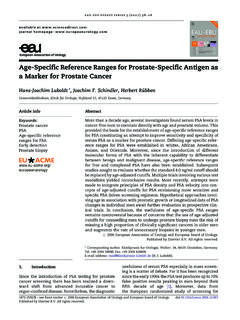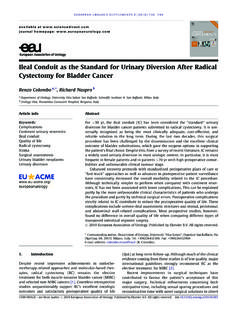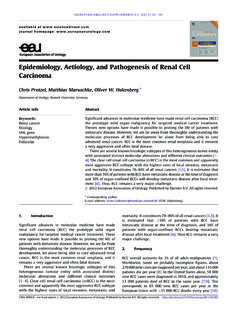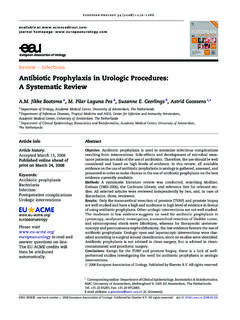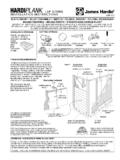Transcription of Epidemiology, Staging, Grading, and Risk …
1 epidemiology , staging , grading , and risk stratification ofBladder CancerMarc Colombela,*, Mark Solowayb, Hideyuki Akazac, Andreas Bo hled, Joan Paloue,Roger Buckleyf, Donald Lammg, Maurizio Brausih, J. Alfred Witjesi, Raj PersadjaDepartment of Urology, Claude Bernard University, Ho pital Edouard Herriot, Lyon, FrancebDepartment of Urology, University of Miami School of Medicine, Miami, Florida, USAcDepartment of Urology, University of Tsukuba, Tsukuba, JapandDepartment of Urology, HELIOS Agnes Karll Hospital, Bad Schwartau, GermanyeDepartment of Urology, Fundacio Puigvert, Universitat Auto` noma de Barcelona, Barcelona, SpainfDepartment of Urology, North York General Hospital, Toronto, Ontario, CanadagDepartment of Surgery, University of Arizona.
2 BCG Oncology, Phoenix, Arizona, USAhDepartment of Urology, AUSL Modena Estense and B Ramazzini Hospitals, Modena, ItalyiDepartment of Urology, Radboud University Nijmegen Medical Centre, Nijmegen, The NetherlandsjDepartment of Urology/Surgery, Bristol Royal Infirmary and Bristol Urological Institute, Bristol, United Kingdomeuropean urology supplements 7 (2008) 618 626available at homepage: infoKeywords:Bladder cancer risk factorsEpidemiologyGradingNon muscle invasivebladder cancerRisk stratificationStagingPlease read andanswer questions EU-ACME credits willthen be :Understanding the epidemiology and risk factors for non muscle invasive blad-der cancer (NMIBC) can assist in the prevention and early detection of the , staging , grading , and risk stratification are critical for determining the mostappropriate management strategies for NMIBC based on risk of recurrence and :To provide community urologists with an overview of the epidemiology ofNMIBC as well as current approaches to staging , grading , and risk acquisition.
3 A committee of internationally renowned leaders in bladder cancermanagement, known as the International Bladder Cancer Group (IBCG), identified currentkey influencing guidelines and published English-language literature related to theepidemiology, staging , and grading of NMIBC available as of March 2008. The IBCG meton four occasions to review the main findings of the identified literature and the currentclinical practice guidelines of the European Association of Urology (EAU), the FirstInternational Consultation on Bladder Tumors (FICBT), the National ComprehensiveCancer Network (NCCN), and the American Urological Association (AUA).Evidence synthesis:Based on this review, the IBCG provided a summary on the epidemiol-ogy of NMIBC and recommendations for the staging , grading , and risk stratification of :Urologists should record the smoking habits of patients and monitor forpossible occupational exposure to urothelial carcinogens.
4 The tumour-node-metastases(TNM) classification for tumour staging and both the World Health Organization (WHO)1973 and 2004 grading systems should be applied for appropriate staging and grading ofNMIBC. Urologists should also consider the use of the European Organisation for Researchand Treatment of Cancer (EORTC) risk tables for risk stratification of NMIBC based on riskof disease recurrence and progression.#2008 European Association of Urology. Published by Elsevier All rights reserved.* Corresponding author. Service D Urologie CHU Edouard Herriot, 5 place d Arsonval,cedex 03, 69437 Lyon, France. Tel. +33 472 11 62 89; Fax: +33 472 11 05 Colombel).1569-9056/$ see front matter#2008 European Association of Urology. Published by Elsevier All rights reserved.
5 Thorough understanding of the epidemiology ofbladder cancer can assist in the prevention and earlydetection of the disease. In addition, staging , Grading, and risk stratification are essential for determiningthe most appropriate management strategies fornon muscle invasive bladder cancer (NMIBC) basedon risk of recurrence and progression. Therefore, acommittee of internationally renowned leaders inbladder cancer management, known as the Interna-tional Bladder Cancer Group (IBCG), identified currentkey influencing guidelines and published English-language literature related to the Epidemiology, staging , and grading of NMIBC available as of March2008. The IBCG met on four occasions to review themain findings of the identified literature and thecurrent clinical practice guidelines of the EuropeanAssociation of Urology (EAU), the First InternationalConsultation on Bladder Tumors (FICBT), theNational Comprehensive Cancer Network (NCCN),and the American Urological Association (AUA).
6 Thisarticle provides a summary of the epidemiology ofNMIBC and the IBCG s recommendations for Staging, grading , and risk stratification of the disease based oncurrently available guidelines and cancer ranks ninth in worldwide cancerincidence. It is the 7th most common cancer in menand the 17th most common cancer in women[1].Globally, the incidence of bladder cancer variessignificantly, with Egypt, Western Europe, and NorthAmerica having the highest incidence rates, andAsian countries the lowest rates (seeFig. 1)[2].Although the disease may occur in young persons,>90% of new cases occur in persons 55 yr of age[3]. factorsThe two most well-established risk factors for bladdertumours are cigarette smoking and occupationalexposure to urothelial carcinogens[4,5].
7 Cigarettesmoking is the most important risk factor, accountingfor 50% of cases in men and 35% in women[5]. In fact,cigarette smokers have a 2- to 4-fold increased risk ofbladder cancer compared to non-smokers[6],andthe risk increases with increasing intensity and/orduration of smoking[7]. Upon cessation of cigarettesmoking, the risk of bladder cancer falls>30% after1 4 yr and>60% after 25 yr[7,8]but never returns tothe level of risk of exposure to urothelial carcinogensis the second most important risk factor, accountingfor 5 20% of all bladder cancers[9,10]. The relativerisk of occupational exposure to carcinogens is likelyunderestimated and varies from country to or historical exposure to aromatic amines(eg, benzidine, 2-naphthylamine, 4-aminobiphenyl,o-toluidine, and 4-chloro-o-toluidine) used in thechemical, rubber, and dye industries[11 13]andpolycyclic aromatic hydrocarbons (PAHs) used in thealuminum, coal, and roofing industries[14]have allbeen associated with the development of bladdercancer.
8 An increased risk of bladder cancer has alsobeen reported in painters, varnishers, and hair-dressers[15].Other environmental exposures that have beenassociated with bladder cancer include chronicurinary tract infections[16], cyclophosphamideuse[17], and exposure to radiotherapy[18]. Recently,the Cancer of the Prostate Strategic UrologicResearch Endeavor (CaPSURE) group found anincreased incidence of bladder cancer in men withprostate cancer treated with radiotherapy[19].Inadequate consumption of fruits, vegetables,and certain vitamins may also play a role in thedevelopment of bladder cancer. A meta-analysis bySteinmaus et al[20]found that increased risks ofbladder cancer were associated with diets low infruit intake (relative risk [RR], ; 95% confidenceinterval [CI], ), and slightly increased riskswere associated with diets low in vegetable intake(RR, ; 95% CI, ).
9 Evidence also suggeststhat garlic[21]and vitamin A[22]have chemo-protective effects in bladder cancer. Furthermore, asmall randomised study of 65 patients with transi-tional cell carcinoma (TCC) of the bladder found thatmegadoses of vitamins A, B6, C, and E plus zincdecreased bladder tumour recurrence in patientsreceiving bacillus Calmette-Gue rin (BCG) immu-notherapy[23]. Large-scale prospective, randomisedtrials are required to clarify the role of vitamins inbladder cancer it has been suggested that coffeeconsumption and artificial sweeteners may be asso-ciated with an increased risk of bladder cancer,results from epidemiologic studies investigatingthese agents have been inconclusive.
10 A majorproblem in evaluating the independent effect ofcoffee consumption on the development of bladdercancer is its relationship to cigarette smoking[1].Toavoid the residual confounding effect of cigarettesmoking, a pooled analysis of studies examining non-smokers in Europe was performed. Although thestudy was limited by bias in control selection, theinvestigators observed a significant increased risk ofeuropean urology supplements 7 (2008) 618 626619bladder cancer only in subjects consuming 10 cupsof coffee per day (odds ratio [OR], ; 95% CI, )[24]. Furthermore, most epidemiologic studies havefailed to show any evidence of bladder carcinogeni-city with saccharin and other sweeteners[1]. In 1999,the International Agency for Research on Cancer(IARC) concluded that saccharin and its salts were notclassifiable as carcinogenic in humans, despiteevidence suggesting that sodium saccharin causesurothelial bladder tumours in experimental animals[25].

